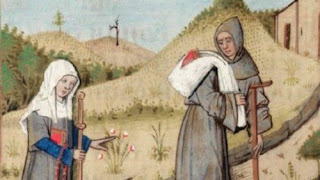He was of both Norman and Welsh descent, a child of the conquerors and the conquered. Educated at the Benedictine house at Gloucester, he was employed by Becket's successor, Richard of Dover, and trusted to manage affairs in Wales such as abuses of consanguinity laws and Welsh church finances. After revealing the existence of a mistress of the archdeacon of Brecon, Gerald was appointed to replace him. The position had a small estate at Llanddew, allowing Gerald to collect tithes of wool and cheese.
His lifelong goal was to become Bishop of St. Davids in Pembrokeshire, Wales. When his uncle (then Bishop of St. David's) died in 1176, the chapter nominated Gerald. King Henry II rejected Gerald's appointment; he may have thought Gerald would be too independent—Wales was hoping to split from the authority of the Archbishop of Canterbury—and Henry had just got over the troubles he had as a result of Becket's martyrdom. Henry appointed a loyal Norman retainer, Peter de Leia. Gerald was also cousin to Rhys ap Gruffydd, a Welsh lord who was understandably hostile to Norman rule. Peter de Leia's relationship with Gruffydd was less than amiable, and Henry liked it that way.
Gerald's historical account includes this (possible) statement from Henry:
It is neither necessary nor expedient for king or archbishop that a man of great honesty or vigor should become Bishop of St. Davids, for fear that the Crown and Canterbury should suffer thereby. Such an appointment would only give strength to the Welsh and increase their pride.
Gerald consoled himself by leaving the country. He spent a year at the University of Paris, studying and teaching canon law and philosophy. In 1180, back in England and continuing to study theology, Bishop Peter de Leia offered him a minor position in the Bishop's household, which he at first accepted but shortly gave up.
Where he becomes of greater interest to modern scholars is in 1184 when he was asked by King Henry to mediate between the Crown and Rhys ap Gruffydd. After, he was sent with Prince John to Ireland, which led to his first important writing: Topographia Hibernica ("Topography of Ireland," although it was mostly history). Not long after he wrote Expugnatio Hibernica ("Conquest of Ireland"), the story of Henry's military campaign there. Both works were revised several times during Gerald's lifetime.
This was the start of both his writing career and his work with several kings. We'll pick up with his map of Ireland—and how his writings were influential right into Tudor times—tomorrow.














